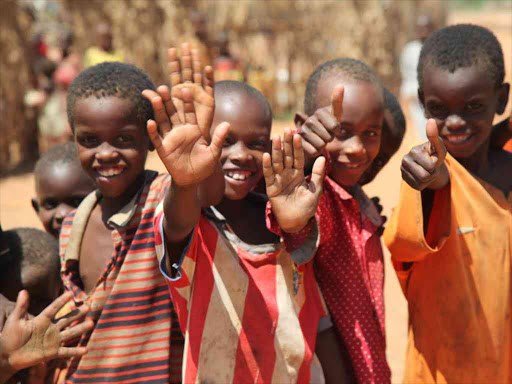
by CYRUS OMBATI
Thursday January 12, 2023

Children in Dabaab refugee camp in Garissa County, May 30, 2018. /THOMSON REUTERS FOUNDATION
Kenya reopened two refugee camps in Garissa county following pressure from various parties.
This was, according to officials, also because of the increasing number of refugees arriving from Somalia.
Interior Cabinet secretary Kithure Kindiki designated the two places as refugee camps in Garissa.
The areas are Ifo II in Daadab ward and Kambioos in Jarajilla ward in Fafi.
"In exercise of the powers conferred by section 28 (2) of the Refugees Act, 2021, the Cabinet secretary for Interior and National Administration designates the areas specified in the Schedule as Refugee Camps," a Gazette notice read.
A section of residents staged celebrations when news of the reopening of the camps came out.
They said this will among others create job opportunities. The two camps were established in 2011 to cater for any influx of refugees.
They were however closed in 2019 following the reduction of the numbers of refugees over the voluntary return programme.
In December 2022, a report by UNHCR said some 24,000 people had arrived in the Dadaab refugee camps from Somalia.
The arrival caused inadequacy of space in the camps, forcing the refugees to reside in makeshift shelters.
Last month, Kindiki held talks with the International Organisation for Migration delegation as part of plans to reopen the camps.
The talks aimed at enhancing the partnership on securing the safe movement of persons between Kenya and Somalia.
The meeting was led by the regional director for East and Horn of Africa, Muhammed Abdiker together with senior officials.
Other camps that are home to Somali refugees include Hagadera, Dagahaley and Ifo.
As of July 2020, the three Daadab refugee camps had a population of 218,873 registered refugees.
After the closure of the camps in 2019, the U.N. refugee agency UNHCR turned the Kambios and Ifo II camps over to Kenyan control.
Some of the refugees went back to Somalia and some were resettled in three other camps in Hagardera, Dagahley and Ifo.
More than 80,000 Somalis were repatriated in the past five years despite criticism from rights groups that said they were being forced to return.
The government has said the Dadaab camp presents security challenges to Kenya and had lost its status as a place of refuge.
According to the U.N. refugee agency, the Dadaab refugee complex hosts more than 200,000 refugees, majority of them are Somalis who fled their country's conflicts and recurring drought.
Since announcing the plan to close the Dadaab camp in May 2016, Kenya has been reluctant to register new refugees.
Al Shabaab militants have been carrying out attacks against Kenyan security forces and civilians since 2011, the year Kenya sent troops to Somalia to fight the militant group.
Kambioos is the newest of the five Dadaab camps.
It was established in August 2011 and officially recognised by the Kenyan government in January 2013.
The camp was originally planned for a population of 100,000 and can help reduce the population pressure in other camps.
Relocation of people from the overcrowded outskirts of Hagadera has started and Kambioos has been receiving urban refugees from Nairobi.
Ifo II is also one of the newest refugee camps in Dadaab.
It was opened in July 2011, to decongest Ifo and Dagahaley camps.
Ifo II is divided into two sub-camps, Ifo II East and Ifo II West, and demarcated into 18 sections comprising four to nine blocks each.
Last October, Fafi MP Salah Yakub while pushing for the reopening of the camps told UNHCR the current drought and hunger crisis ravaging the Horn of Africa and northern Kenya has resulted in an influx of refugees in the country.
“Further, the threat of famine in Somalia and Ethiopia has seen thousands of new arrivals most of them women and children in Fafi and Dadaab subcounties in Garissa, creating an emergency situation that calls for the establishment of a new settlement site to cope with the increasing flow of refugees,” he said in a letter.
“There are already approximately 100,000 non profiled and unregistered refugees living within the Hagadera camp in Fafi constituency and more arrivals are expected due to the prolonged drought that has caused mass starvation.”
Yakub said the growing number of incoming refugees necessitates the establishment of a new settlement site since the existing camps in Hagadera, Dagahaley and Ifo are congested.
“International law stipulates that refugee camps be restricted to no more than 30,000 persons. The Dadaab refugee camp complex hosted 234,025 refugees and asylum seekers as of February 28, 2022," he said.
"Of these 98 per cent were from Somalia but the figure is feared to have risen to around 300,000 refugees, since the latest arrivals due to the drought and hunger situation in the region.”
The legislator said following extensive surveys and consultations with various national and county government officials, it was established the camps are the most suitable location for the re-establishment of the refugee settlement camps, considering security is still intact.
He cited security, good road network, refugee presence and water availability among others as the reasons the camps should be reopened.